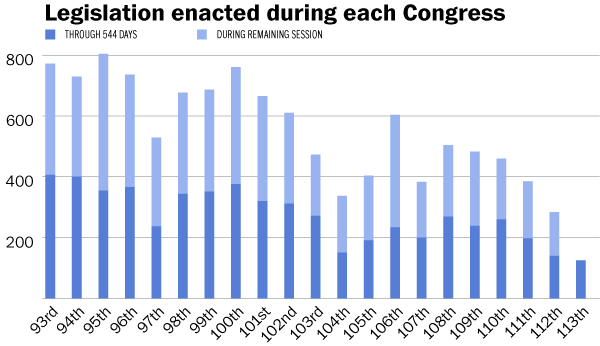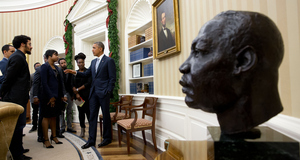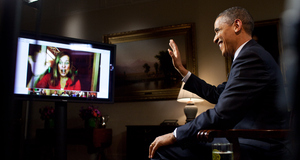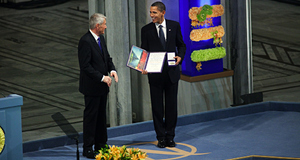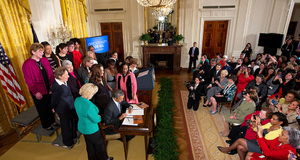The Obama PresidencyInaction on Gun Control Reform During the Obama Administration
By
2015, Vol. 7 No. 02 | pg. 3/3 | « Increasing Partisanship and the Inability to LegislateIt’s clear that there are a myriad of moving parts related to the issue of gun control. The various legislation that has been passed over the last 80 years provides a backdrop for understanding what ignited the debate over firearm legislation. The various legal battles, most importantly the 2008 and 2010 decisions by the Supreme Court, have demonstrated how contentious of an issue gun control is. Despite the high level battles over gun control, substantial public support for reform indicates this is an issue is a viable possibility and an opportunity for compromise and reform legislation. However, viability of success based on public support is contingent on one key factor: congressional action mirroring that public support. As an individual, President Obama is able to focus on public opinion and support to recommend reforms from the bully pulpit. Unfortunately, the President can’t pass legislation simply by speaking about it. Enacting legislation is the responsibility of Congress, a large body of individuals, each of whom are subject to a variety of forces beyond public support. This is where the Supreme Court decision in Citizens United becomes important. The vast increase in political spending and contributions overall is only part of the Citizen’s United decision’s impact on lack of action on gun control. Looking more specifically at spending by the key lobbying group against reform, the National Rifle Association (NRA), there is an obvious pattern. During the 2006 election cycle, the NRA spent $2,059,486. Throughout the 2014 cycle, the organization spent $30,923,860, a 1402% increase in spending.34 This increase in spending by the NRA aligns with a vast increase in overall spending by all outside groups. More importantly, due to the absence of disclosure requirements in the Citizens United decision, this number does not include organizations or individuals that may be closely aligned with goals of the NRA that are no longer required to disclose who their donors are. Given this drastic increase in spending, it is essential to consider the effect outside spending has had on the polarization of Congress.Over the last century, Congress has become substantially more polarized. The average ideological score (AIS) over time of both the Democrats and the Republicans calculated by the Brookings Institution makes this trend clear. On this scale, a negative number represents a liberal perspective while a positive number indicates a conservative ideology. The further a number is from zero, the more conservative or liberal that Congress is. Finally, the greater the difference between the two numbers, the more polarized the two parties are. During the 73rd Congress that was in office from 1933 through 1934 and was responsible for the National Firearms Act, the AIS was -0.183 for Democrats and 0.321 for Republicans, a 0.504 differential between the parties. The 93rd Congress that held office from 1973 through 1974, the AIS was -0.299 for Democrats and 0.231 for Republicans, a 0.530 differential. The 103rd Congress that held office from 1993 to 1994 and was responsible for the Brady Handgun Violence Prevention Act, the AIS was -0.335 for Democrats and 0.405 for Republicans, a 0.740 differential. More recently, in the 109th Congress that held office from 2005 through 2006, the AIS was -0.381 for Democrats and 0.596 for Republicans, a 0.977 differential. From 1934 to 2006, there was an increase in the differential between parties of 0.473. This change took place over 72 years from 1934 to 2006, which indicates a 0.00656 increase in differential “points” per year.35 Looking at the last several Congresses to hold office, the rate of increase in polarization has risen substantially. In 2006, the differential was 0.977. During the 110th Congress that served from 2007 through 2008, the differential was 0.988 (D: -0.36; R: 0.628). In the 111th Congress that held office from 2009 through 2010, the differential increased to 1.001 (D: -0.343; R: 0.658) and in 112th Congress, in office from 2011 through 2012, the differential increased yet again to 1.064 (D: -0.394; R: 0.675).35 While these increases in the difference in ideologies between the Democratic and Republican parties were relatively gradual during the mid to late 1990s, between 2006 and 2012, the differential has increased at a rate of 0.0145 “points” per year. This represents a 220% increase over the rate of 0.00656 “points” per year between 1934 and 2006. As conservatives have become more conservative and liberals more liberal, Congress has become more polarized each year. There may be a variety of reasons that partisanship and polarization have increased during the last several Congresses, however it is interesting and noteworthy that as the amount of political spending increased, so did the rate of increase in polarization. It is important to look at the effect of this increased polarization. One obvious trend (see chart 1) has been the vast decrease in the number of bills passed by Congress as polarization increased. Looking back to the days of the 95th Congress, held office from 1977 through 1978, nearly 800 pieces of legislation were passed. Looking forward to more recent Congresses, the 109th Congress passed just under 500 pieces of legislation, roughly a 40% decrease. Each subsequent Congress continued to pass fewer pieces of legislation. In the currently active 113th Congress, just over 100 pieces of legislation have been passed. This is roughly a 75% decrease from the 109th Congress less than a decade ago and roughly an 85% decrease from the 95th Congress in the mid 1970s.36 Chart: Washington Post It seems unlikely that this Congress will alter the trend of passing substantially fewer laws. President Obama has increasingly pushed for gun control reforms that are supported by the public. Yet, despite several bills coming to floor of the Senate, there has been no substantial change in law. An increase in polarization due to increases in campaign spending and contributions is at least partially to blame. Again, looking more specifically at the issue of gun control, four bills were recommended to the Senate, passed in the Judiciary Committee, and failed to pass the larger body, much less move on to the House or the President’s desk for signing. The Senate even attempted a more piecemeal approach by introducing nine individual amendments that would have enacted small and narrow reforms. Of these, 7 failed to pass, and of the 2 that did, one was in favor of gun rights advocates. To date, none of the proposed reforms, including expanded background checks for private sales, transfers, and gun shows, a federal assault weapons ban (including bans on high capacity ammunition magazines), and bans on armor piercing bullets have even made it out off the Senate floor. One can hardly ignore the nearly 2000% increase in outside spending made possible by the Citizens United decision. Similarly, the NRA increased their spending nearly 1400% over the same time frame. This increase in spending contributes, at least in part, to the substantial increase in polarization in Congress over the last decade. The members and parties of Congress continue to move further and further apart on the ideological scale, making compromise on legislation more and more unlikely. This increase in polarization and ensuing lack of ability to compromise has led to a standstill when it comes to passing legislation. As a result, there has been no legislation passed to further these gun control reforms proposed by President Obama and supported by the American public. Predictions for the FutureIt’s not clear whether President Obama’s proposals for gun control legislation will move forward. It is clear, however, that the political landscape has been altered for the foreseeable future as a result of Citizens United. Prior to the Citizens United ruling, two other Supreme Court decisions opened the doors for new gun rights, rules, and regulations. These decisions also brought great attention to the organizations that influence this policy, such as the NRA. After Citizens United, the NRA and others were able to considerably increase their influence through campaign spending to ensure their policy goals were considered. This increase in spending has driven both parties in Congress further apart. The result is inaction on a myriad of issues, one of which has been gun control. What happens next is much more important. The advent of campaign spending by outside groups, creation of super PACs, and the ability to donate funds without disclosing their source show no sign of slowing. These trends are likely one cause of the increased partisanship in Congress, which has led to inaction on gun control. In the case that polarization begins to decline and the two parties find more common ground, Congress may begin to pass compromise legislation on gun control. However, a different path will likely prove more successful. Gun control has received substantial attention at federal level, but numerous states and municipalities have succeeded in passing reforms. As of April 2014, sixteen states and Washington D.C. have passed laws requiring background checks for all gun sales. In these 16 states, 38% less women are murdered with a firearm by an intimate partner and 49% less people commit suicide with a firearm. Furthermore, these states have 17% fewer aggravated assaults with handguns, 39% fewer law enforcement deaths with guns, and 64% fewer crime guns (guns sold in-state and then recovered at a crime scene in another state) exported.37 This is just one example of legislation that has been successful at the state level. At the local level, former Mayors Michael Bloomberg of New York City and Thomas Menino of Boston formed Mayors Against Illegal Guns in 2006. Since its’ founding, over one thousand current and former mayors from around the country have joined the coalition to fight for gun control reforms at the local level. The issue of gun control is not going away regardless of the inaction at the federal level. Anyone pretending that the issue does not exist or that guns are not the problem fails to accept the reality. Every day, more people are shot and killed by firearms. Every day, more guns fall into or are sold into the hands of those who should not be allowed to have access to them. If Congress and the political system at the federal level fail to move forward on this issue, the focus should move to where policies have been successful, the state and local level. The United States of America must find a solution to gun deaths and crimes and waiting for action at the federal level simply isn’t worthwhile. Endnotes1.) Washington Post, Olga Khazan, Here’s how U.S. gun violence compare with the rest of the world (12/14/12), 11/10/14 2.) LA Times, Jerry Hirsch, 253 million cars and trucks on U.S. roads… (6/9/14), 11/11/14 3.) Pew Research Center, A minority of Americans own guns, but just how many is unclear (6/3/13), 11/11/14 4.) Brady Campaign to Prevent Gun Violence (2008-2012), 11/11/14 5.) Chris Christoff and Ilan Kolet, American Gun Deaths to Exceed Traffic Fatalities by 2015 (Bloomberg, 12/19/12) 11/15/14 6.) Max Fisher, What makes America’s gun culture totally unique in the world, in four charts (Washington Post, 12/15/12) 11/16/14 7.) William Krouse, Gun Control Legislation (Congressional Research Service, 11/14/12), 11/11/14 8.) Ibid., pg. 14 9.) Ibid., pg. 15 10.) Ibid., pg. 15 11.) Ibid., pg. 111 12.) Ibid. pg. 111 13.) Chris Christoff and Ilan Kolet, American Gun Deaths to Exceed Traffic Fatalities by 2015 (Bloomberg, 12/19/12) 11/15/14 14.) U.S. Department of Justice, A Study of Active Shooter Incidents in the United States Between 2000 and 2013 (September 2014) 11/15/14 15.) Ibid., pg. 2 16.) William Krouse, Gun Control Legislation in the 113th Congress, pgs. 1-2 (CRS, 8/1/2014) 11/12/14 17.) Ibid., pg. 4 18.) Ibid. pg. 4 19.) Pew Research Center, Broad Support for Renewed Background Checks Bill, Skepticism About Its Chances (May 2013) 11/11/14 20.) Gallup Historical Trends, Guns (11/11/14) 21.) Ibid., pg. 4 22.) Ibid., pgs. 6-8 23.) Cornell University Legal Information Institute, District of Columbia v. Heller (2008) 11/11/14 24.) BaoBao Zang, McDonald v. Chicago (PBS, 2010) 11/11/14 25.) Citizens Untied v. Federal Election Commission, OpenSecrets.org 11/14/14 26.) Spencer MacColl, Citizens United Decision Profoundly Affects Political Landscape (OpenSecrets.org, 5/5/11) 11/15/14 27.) Ibid. 11/15/14 28.) Andrew Mayersohn, Four Years After Citizens United: The Fallout (Center for Responsive Politics, 1/21/14) 11/15/14 29.) Price of Admission, Center for Responsive Politics 11/17/14 30.) Supreme Court Hands Down Key Campaign Finance Decision – Repeals Unconstitutional Restrictions on Political Speech (NRA-ILA, 1/21/10) 11/14/14 31.) Wesley Lowery, How Congress became so partisan, in 4 charts (Washington Post, 4/14/14) 11/14/14 32.) Philip Bump, The 113th Congress is historically good at not passing bills (Washington Post, 7/9/2014) 11/12/14 33.) Drew Desilver, Partisan Polarization, in Congress and among public, is greater than ever (Pew Research Center, 7/17/2013) 11/12/14 34.) Center for Responsive Politics, Outside Spending by Group 11/15/14 35.) Brookings Institution, Historical House Ideology and Party Unity, 35th – 113th Congress (1857-2014) 11/15/14 36.) Philip Bump, The 113th Congress is historically good at not passing bills (Washington Post, 7/9/2014) 11/14/14 37.) Everytown for Gun Safety (April 2014) 11/20/14 Suggested Reading from Inquiries Journal
Inquiries Journal provides undergraduate and graduate students around the world a platform for the wide dissemination of academic work over a range of core disciplines. Representing the work of students from hundreds of institutions around the globe, Inquiries Journal's large database of academic articles is completely free. Learn more | Blog | Submit Latest in Political Science |

